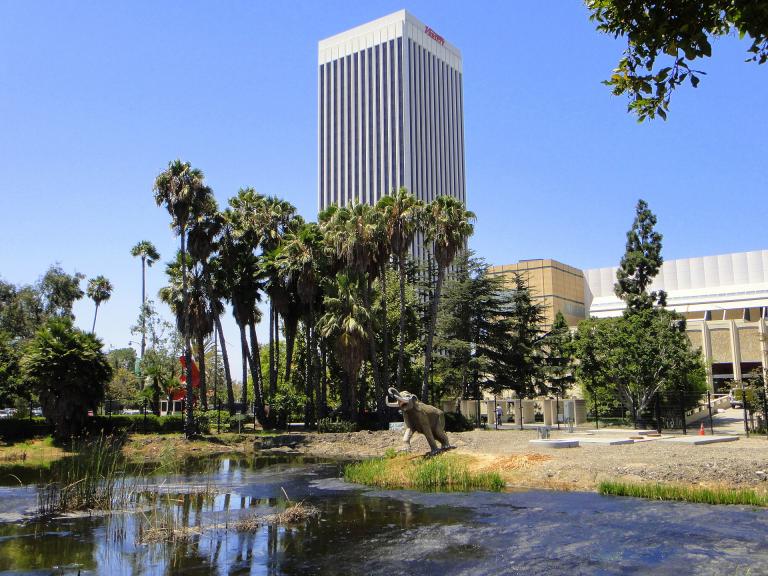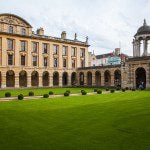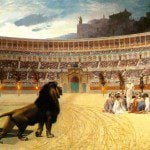
(Wikimedia Commons public domain image)
***
We drove to Hancock Park today to meet with friends that we’ve known since our days of living in Egypt. They’re now living in the Los Angeles area, and the ones that we first knew when they were children now have (very lively) children of their own. We gawked at the La Brea Tar Pits, of course, but spent most of our time in the adjacent George C. Page Museum (and then at a leisurely lunch with good conversation thereafter). I used to come to the Tar Pits on school field trips when I was a kid, and I’ve visited them more times than I could ever begin to count. (Which, you must understand, has to have been an acutely painful experience for me, since, as I’ve learned over the years from several critics online who don’t know me, I’m a young-earth creationist who believes that the world is only about six or seven thousand years old.) But the museum is a vast improvement over what was there when I was a schoolboy, and the exhibits in the museum are much improved even over what we saw when we were living in West Los Angeles and bringing our own kids to the Tar Pits. (And I loved the tee shirt on sale in the Museum’s gift shop that reads “What happens in the La Brea Tar Pits stays in the La Brea Tar Pits.”)
After we bade our friends adieu, needing to occupy just a short bit of time, my wife and I decided to visit the Westwood Village Memorial Park cemetery, which is hidden just off of Wilshire Boulevard in such a way that only those deliberately looking for it would ever know that it’s there. Anyway, I’m a history nut, and there are few things that are more interesting to me than people and their biographies. So historic cemeteries are fascinating to me, too. (I’m still wanting to spend more time at the Hollywood Cemetery in Richmond, Virginia.) And this particular tiny cemetery, Westwood Village Memorial Park, is absolutely rich with history of a certain kind — very different history, of course, from Arlington National Cemetery, where we spent several hours walking about last month — as you can readily see from the list of people who are interred there.
It’s an excellent place for reflection, too. For what has long been called memento mori. After all of the fame and the glory that many of the residents of the cemetery enjoyed during their lifetimes, did it really all just come down to this? And the idea that Hugh Hefner is entombed right next to Marilyn Monroe? (He spent big money for the spot.) It seems incredibly tacky to me. In the face of death, in a cemetery, Hefner’s adolescent male-fantasy “Playboy philosophy” seems irrelevant and, well, more than a little out of place.
***
I’m still going through old blog entries, culling notes from them for future writing purposes. Tonight, I drew out the following quotations, which are all basically on the subject of science and religion. I hope that you’ll find them interesting:
Science and religion . . . are friends, not foes, in the common quest for knowledge. Some people may find this surprising, for there’s a feeling throughout our society that religious belief is outmoded, or downright impossible, in a scientific age. I don’t agree. In fact, I’d go so far as to say that if people in this so-called ‘scientific age’ knew a bit more about science than many of them actually do, they’d find it easier to share my views. (Sir John Polkinghorne, theoretical physicist, Anglican priest, and theologian)
Two quotations from Modern Physics and Ancient Faith, by Stephen M. Barr, a cosmologist and theoretical particle physicist at the University of Delaware:
“Science has given us new eyes that allow us to see down to the deeper roots of the world’s structure, and there all we see is order and symmetry of pristine mathematical purity.”
“The universe looks far more orderly to us now than it did to the ancients who appealed to that order as proof of God’s existence.”
“The first gulp from the glass of natural sciences will turn you into an atheist, but at the bottom of the glass God is waiting for you.” (Werner Heisenberg, 1932 Nobel Laureate in Physics)
Joseph H. Taylor, Jr., Princeton University astrophysicist and 1993 Nobel laureate for his work on binary pulsars
“A scientific discovery is also a religious discovery. There is no conflict between science and religion. Our knowledge of God is made larger with every discovery we make about the world.” (Joseph H. Taylor, Jr., Princeton University astrophysicist and 1993 Nobel laureate for his work on binary pulsars)
“This sense of wonder leads most scientists to a Superior Being – der Alte, the Old One, as Einstein affectionately called the Deity – a Superior Intelligence, the Lord of all Creation and Natural Law.” (Abdus Salam, 1979 Nobel Laureate in Physics)
Two passages from the Anglo-American theoretical physicist Paul Davies, winner of the 2001 Kelvin Medal from the Institute of Physics and the 2002 Faraday Award from the Royal Society:
People take it for granted that the physical world is both ordered and intelligible. The underlying order in nature-the laws of physics-are simply accepted as given, as brute facts. Nobody asks where they came from; at least they do not do so in polite company. However, even the most atheistic scientist accepts as an act of faith that the universe is not absurd, that there is a rational basis to physical existence manifested as law-like order in nature that is at least partly comprehensible to us. So science can proceed only if the scientist adopts an essentially theological worldview.
It may seem bizarre, but in my opinion science offers a surer path to God than religion.
Proof is only applicable to very rarefied areas of philosophy and mathematics. . . . For the most part we are driven to acting on good evidence, without the luxury of proof. There is good evidence of the link between cause and effect. There is good evidence that the sun will rise tomorrow. There is good reason to believe my mother loves me and is not just fattening me up for the moment when she will pop arsenic into my tea. And there is good reason to believe in God. Very good reason. Not conclusive proof, but very good reason just the same. . . . I believe it is much harder to reject the existence of a supreme being than accept it. (Rev. Canon Dr. Michael Green, of Oxford, in Faith for the Non-religious)
Posted from Los Angeles, California












